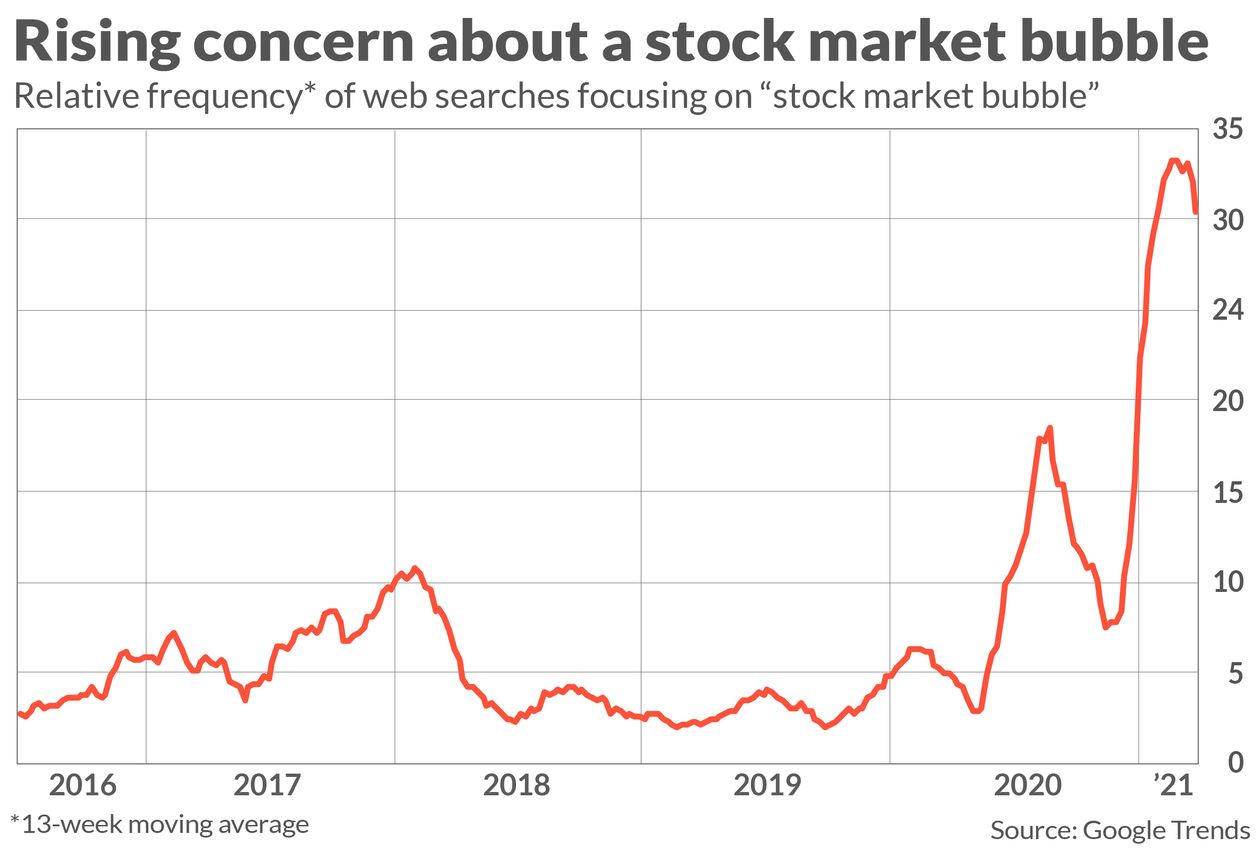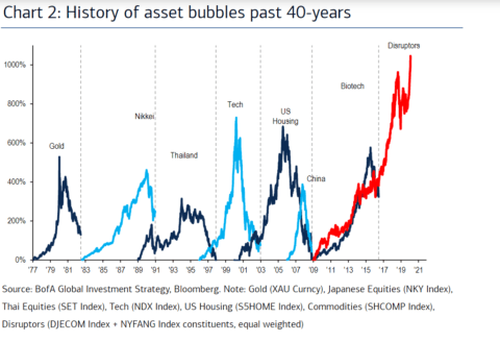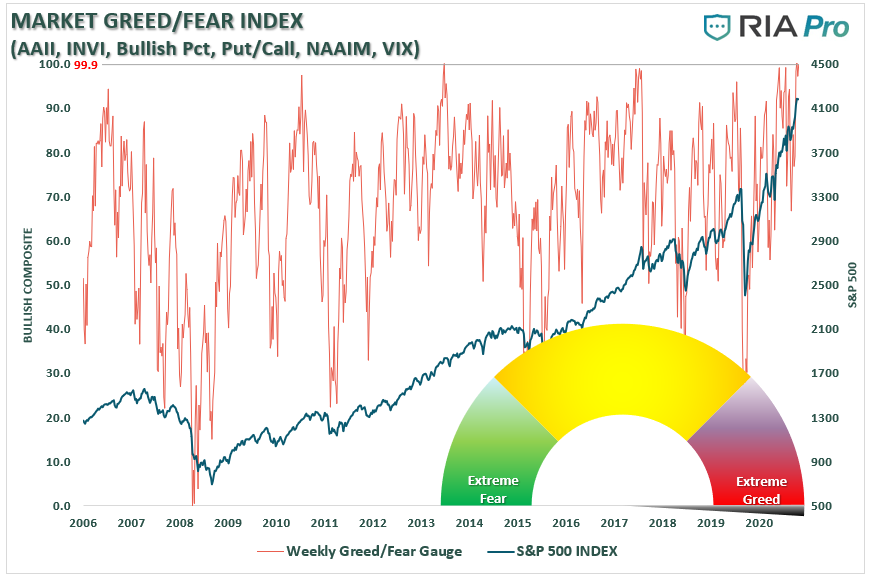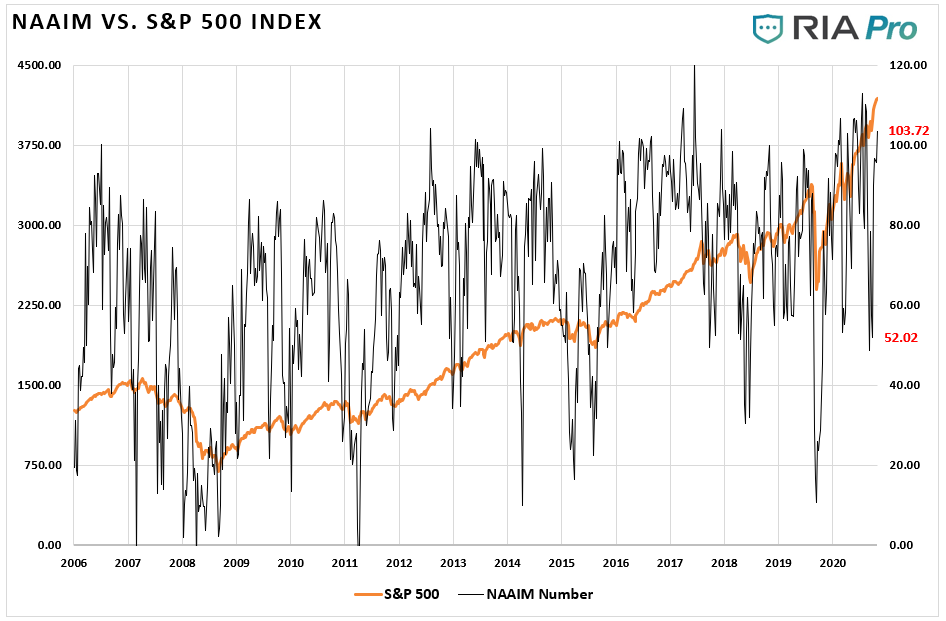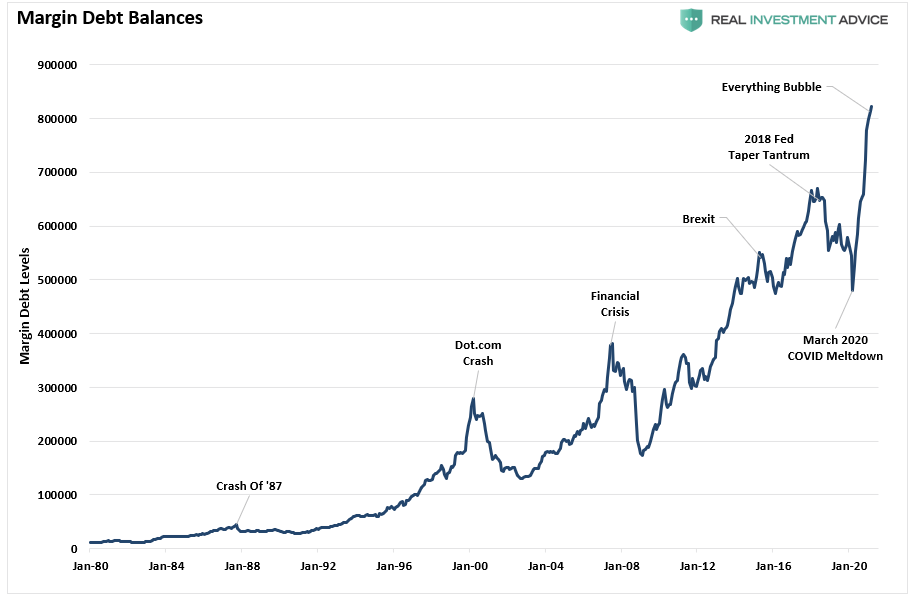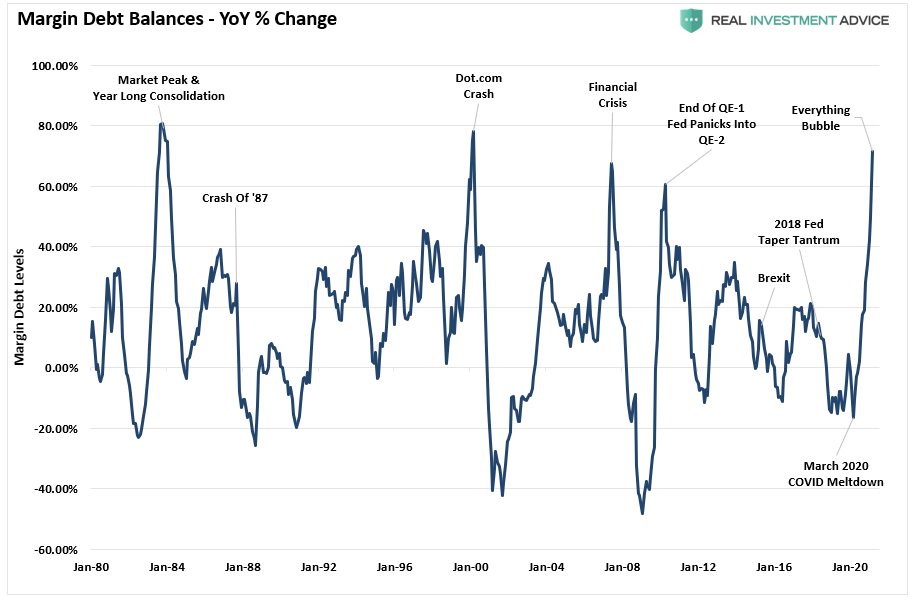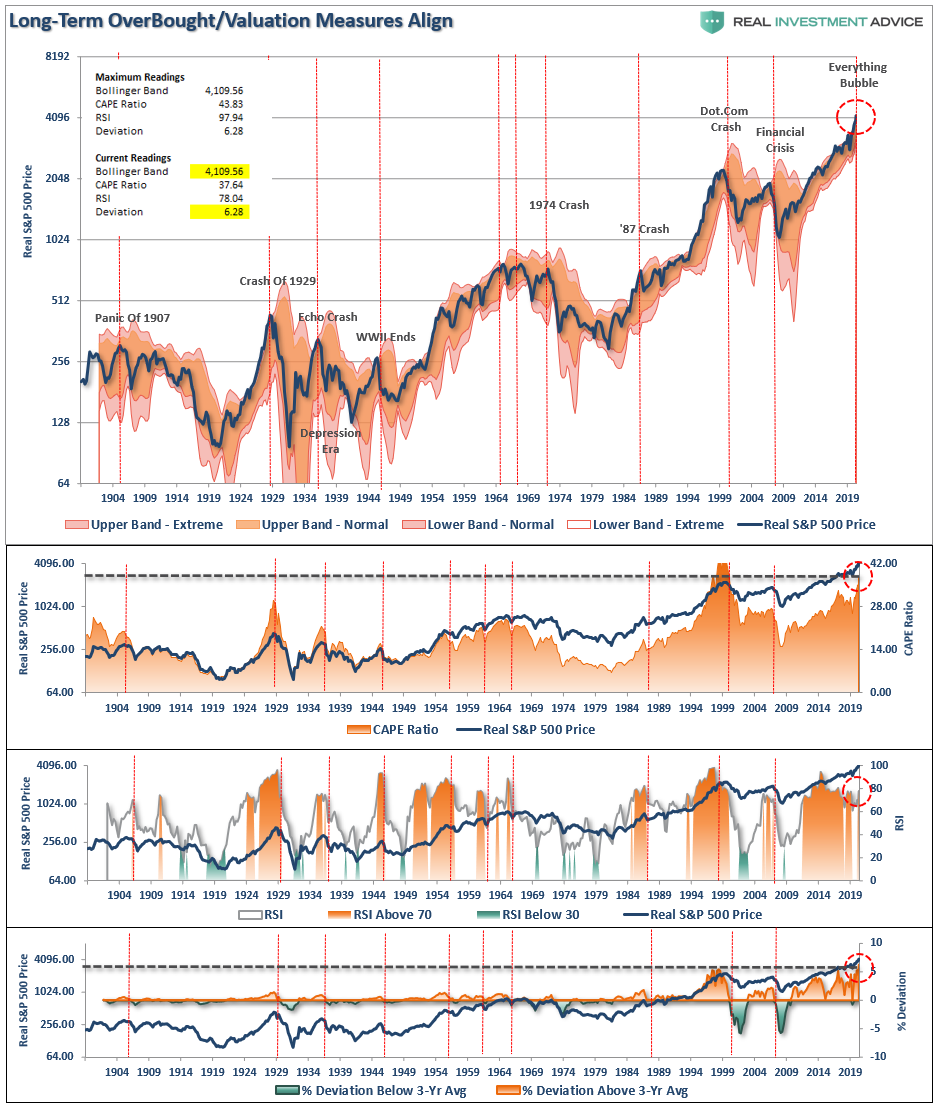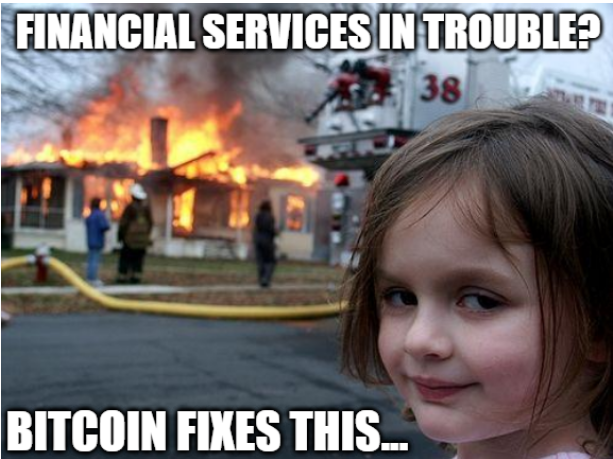“If everyone sees it, is it still a bubble?” That was a great question I got over the weekend. As a “contrarian” investor, it is usually when “everyone” is talking about an event; it doesn’t happen. As Mark Hulbert noted recently, “everyone” is worrying about a “bubble” in the stock market. To wit: “To appreciate how widespread current concern about a bubble is, consider the accompanying chart of data from Google Trends. It plots the relative frequency of Google searches based on the term ‘stock market bubble.’ Notice that this frequency has recently jumped to a far-higher level than at any other point over the last five years.” Concern of Stock Market Bubble, 2016 - 2021 - Click to enlarge What Is A Bubble? “My confidence is rising quite rapidly that this
Topics:
Lance Roberts considers the following as important: 9) Personal Investment, 9a.) Real Investment Advice, Featured, Investing, newsletter, Technically Speaking
This could be interesting, too:
Nachrichten Ticker - www.finanzen.ch writes Die Performance der Kryptowährungen in KW 9: Das hat sich bei Bitcoin, Ether & Co. getan
Nachrichten Ticker - www.finanzen.ch writes Wer verbirgt sich hinter der Ethereum-Technologie?
Martin Hartmann writes Eine Analyse nach den Lehren von Milton Friedman
Marc Chandler writes March 2025 Monthly
| “If everyone sees it, is it still a bubble?” That was a great question I got over the weekend. As a “contrarian” investor, it is usually when “everyone” is talking about an event; it doesn’t happen.
As Mark Hulbert noted recently, “everyone” is worrying about a “bubble” in the stock market. To wit:
It plots the relative frequency of Google searches based on the term ‘stock market bubble.’ Notice that this frequency has recently jumped to a far-higher level than at any other point over the last five years.” |
Concern of Stock Market Bubble, 2016 - 2021 |
What Is A Bubble?
What is the definition of a bubble? According to Investopedia:
|
History of Asset Bubbles, 1977 - 2021 |
| Rather, the price does not align with the fundamentals of the asset.“
This definition is suitable for our discussion; there are three components of a “bubble.” The first two, price and valuation, are readily dismissed during the inflation phase. Jeremy Grantham once produced the following chart of 40-years of price bubbles in the markets. During the inflation phase, each was readily dismissed under the guise “this time is different.” We are interested in the “third” component of “bubbles,” which is investor psychology. |
 |
A Bubble In PsychologyAs Howard Marks previously noted:
Currently, it’s difficult for investors to become any more enthusiastic about market returns. (The RIAPro Fear/Greed Index compiles measures of equity allocation and market sentiment. The index level is not a component of the measure that runs from 0 to 100. The current reading is 99.9, which is a historical record.) |
Market Greed/Fear Index, 2006 - 2020 |
|
Such is an interesting juxtaposition. On the one hand, there is a rising recognition of a “bubble,” but investors are unwilling to reduce “equity risk” for “fear of missing out or F.O.M.O.” Such was a point noted explicitly by Mark:
In other words, investors have fully adopted the “Greater Fool Theory.” |
 |
Okay, Boomer!I know. The discussion of “valuations” is an old-fashioned idea relegated to investors of an older era. Such was evident in the pushback on Charlie Munger’s comments about Bitcoin recently:
In 1999, when Buffett spoke out against “Dot.com” stocks, he got dismissed with a similar ire of “investing with Warren Buffett is like driving ‘Dad’s old Pontiac.’” Today, young investors are not interested in the “pearls of wisdom” from experienced investors. |
 |
Today, they are “out of touch,” with the market’s “new reality.”
Of course, the problem with information doled out by 22-year olds is they were 10-year olds during the last “bear market.” Given the lack of experience of investing during such a market, as opposed to Warren Buffett who has survived several, is the eventual destruction of capital. |
|
Plenty Of Analogies
It’s one of those things that once it starts going up, it might keep going up.’” – Mark Hulbert That exuberance shows up with professionals as well. As of the end of April, the National Association Of Investment Managers asset allocation was 103%. |
NAAIM vs. S&P 500 Index, 2006 - 2020 |
As Dana Lyons noted previously:
Give Me MoreOf course, margin debt, which is the epitome of “speculative appetite,” soared in recent months. |
Margin Debt Balances , Jan 1980 - 2020 |
| As stated, “bubbles are about psychology,” which the annual rate of change of leverage shows. |
Margin Debt Balances - YoY Change, Jan 1980 - 2020 |
| Another form of leverage that doesn’t show up in margin debt is ETF’s structured to multiply market returns. These funds have seen record inflows in recent months.
With margin debt reaching levels not seen since the peak of the last cyclical bull market cycle, it should raise some concerns about sustainability. It is NOT the level of leverage that is the problem as leverage increases buying power as markets are rising. The unwinding of this leverage is critically dangerous in the market as the acceleration of “margin calls” leads to a vicious downward spiral. Importantly, this chart does not mean that a massive market correction is imminent. It does suggest that leverage, and speculative risk-taking, are likely much further advanced than currently recognized. |
US Equity ETF AUM, 2007 - 2021 |
Pushing ExtremesPrices are ultimately affected by physics. Moving averages, trend lines, etc., all exert a gravitational pull on prices in both the short and long term. Like a rubber band, when prices get stretched too far in one direction, they have always eventually “reverted to the mean” in the most brutal of manners. The chart below shows the long-term chart of the S&P 500 broken down by several measures: 2 and 3-standard deviations, valuations, relative strength, and deviations from the 3-year moving average. It is worth noting that both standard deviations and distance from the 3-year moving average are at a record. During the last 120-years, overvaluation and extreme deviations NEVER got resolved by markets going sideways. |
Long-Term OverBought/Valuation Measures Align, 1904 - 2019 |
| The only missing ingredient for such a correction currently is simply a catalyst to put “fear” into an overly complacent marketplace. Anything from economic disruption, a credit-related crisis, or an unexpected exogenous shock could start the “panic for the exits.” |  |
Conclusion
There is more than adequate evidence a “bubble” exists in markets once again. However, as Mark noted in his commentary:
‘I have no idea whether the stock market is actually forming a bubble that’s about to break. But I do know that many bulls are fooling themselves when they think a bubble can’t happen when there is such widespread concern. In fact, one of the distinguishing characteristics of a bubble is just that.”
However, he concludes with the most important statement:
“It’s important for all of us to be aware of this bubble psychology, but especially if you’re a retiree or a near-retiree. That’s because, in that case, your investment horizon is far shorter than for those who are younger. Therefore, you are less able to recover from the deflation of a market bubble.”
Read that statement again.
Millennials are quick to dismiss the “Boomers” in the financial markets today for “not getting it.”
No, we get it. We have just been around long enough to know how these things eventually end.
The post Technically Speaking: If Everyone Sees It, Is It Still A Bubble? appeared first on RIA.
Tags: Featured,Investing,newsletter,Technically Speaking

